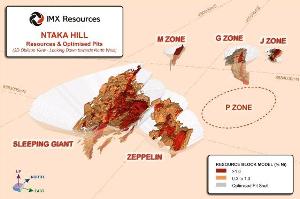Dec 10 2013
IMX Resources Limited advises that the latest drilling results from its Ntaka Hill Nickel Sulphide Project in south-eastern Tanzania, have confirmed the discovery of a new zone of nickel sulphide mineralisation immediately adjacent to the current resources.
 Ntaka Hill – Location of P Zone relative to current resources
Ntaka Hill – Location of P Zone relative to current resources
The new zone, referred to as "P Zone", lies approximately 400m east of the existing Zeppelin and Sleeping Giant deposits, which host the current resources at Ntaka Hill, and 700m south of 'G' and 'J' Zones.
P Zone, which was discovered during the 2013 drilling program, has been intersected in four diamond drill holes, with assay results including:
- 11.4m at 0.51% Ni and 0.15% Cu from 211m down-hole (NAD13-369);
- 2.0m at 1.1% Ni from 266m and 3.4m @ 1.2% Ni from 272.4m down-hole (NAD13-375);
- 3.0m @ 0.4% Ni from 186m down-hole (NAD13-376); and
- 17.0m @ 0.4% Ni from 223m and 9.3m @ 0.4% Ni from 272.7m down-hole (NAD13-377).
The holes drilled in the last two months at Ntaka Hill have been designed to test potential extensions to the J, G, M, and P Zones within the Ntaka Hill intrusion and establish the broader scale and potential of the Ntaka Hill Project to host a globally significant nickel sulphide system.
Modelling of P Zone indicates that it is potentially an up-dip extension of the mineralisation at Zeppelin and Sleeping Giant to the west and south-west. Based on this interpretation, the joint venture believes there is excellent potential to significantly increase the size of the Sleeping Giant and Zeppelin resources with further drilling.
Assay results have also been received for hole NAD13-378, which was drilled 100m to the south of the recently reported high-grade intersection in drill hole NAD13-372 which intersected 13.65m @ 3.46% Ni and 0.62% Cu from 357.9m within the Sleeping Giant resource (see ASX News Release, 1 November 2013). IMX confirms that since announcing the assay results on 1 November 2013, it is not aware of any new information or data that materially affects the information included in that announcement
This hole, which did not intersect significant mineralisation, was drilled as part of the broader exploration systematic coverage of the Ntaka Hill mafic intrusive, not specifically as a follow-up hole to test the previously announced off-hole conductor from hole NAD13-372.
IMX's Acting Managing Director John Nitschke said the latest results from the 2013 drilling program clearly indicated the potential for the Ntaka Hill Project to host a single, large scale mineralised system extending to the south and east of the Zeppelin deposit.
"We are particularly encouraged by the discovery of a significant new area of mineralisation at P Zone which appears to be the up-dip extension of the main deposits," he said. "This confirms that Ntaka Hill hosts multiple zones of mineralisation that appear to be linked and clearly have the potential to form part of a very sizeable, single deposit. Our work suggests that this system is approximately 1.5km wide and remains open to the south and east.
"More drilling will be required to define the broader extent of this very large system and also to help us to vector in on higher grade zones of mineralisation within it," Mr Nitschke added. "Extensive programs of 'deep-looking' geophysical surveys are also underway to test the broader potential of the Ntaka Hill-Lionja corridor. Results from this work should be available early in the New Year, providing drill targets for the 2014 drilling season."
Exploration at Ntaka Hill is being managed and sole funded by IMX's joint venture partner, MMG Exploration Holdings Limited, under a US$60 million earn-in joint venture covering both Ntaka Hill and the surrounding 7,000 sq km Nachingwea Project. The Stage 1 exploration commitment is US$10 million by September 2014.
MMG is targeting high-grade nickel mineralisation within plunging tubular bodies or chonoliths, with an exploration target in the order of 27 million tonnes grading at or above 1.5% Ni.